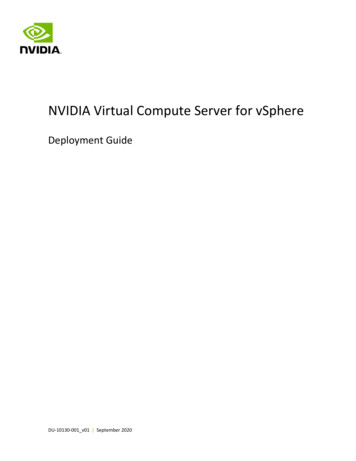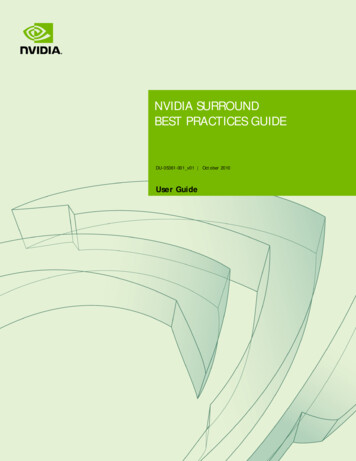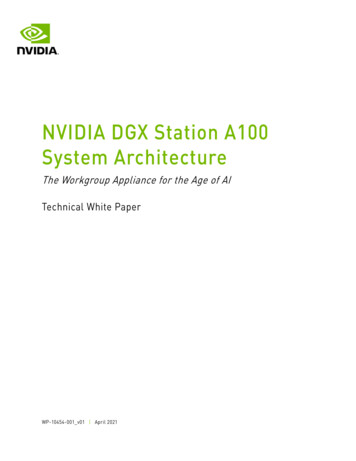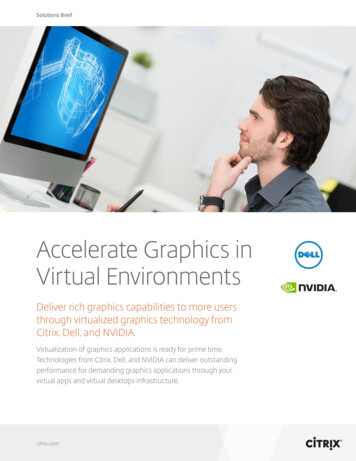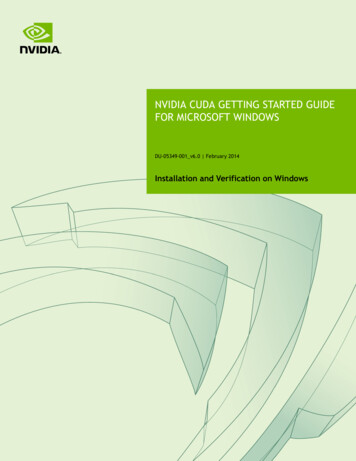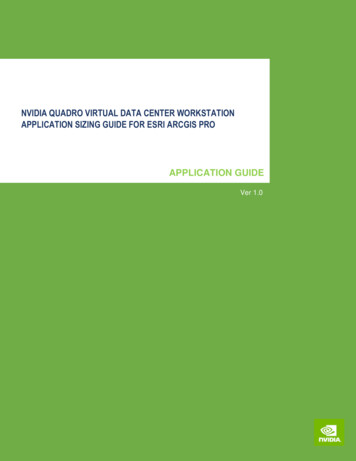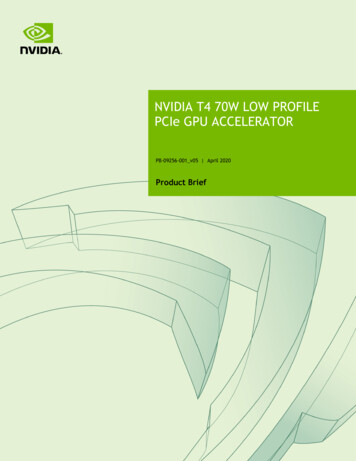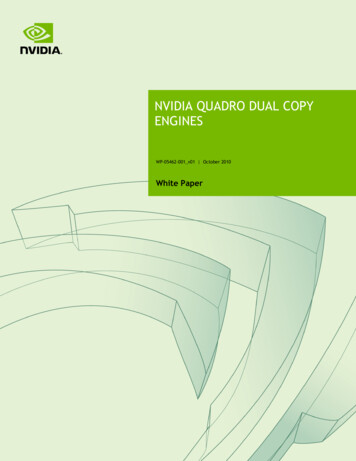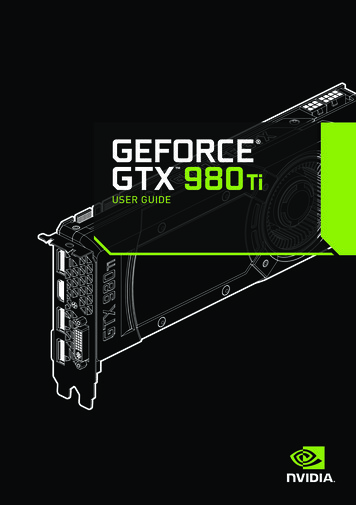
Transcription
USER GUIDE
GEFORCE GTX 980 TI INSTALL ATION GUIDENVIDIA GeForce GTX 980 Ti
Table of ContentsTable of ContentsIntroduction 1About This Guide 1Minimum System Requirements 2Unpacking 3Equipment 3Hardware Installation Safety Instructions Before You Begin Installing the GeForce Graphics Card 5566Software Installation GeFore Experience Software Installation Driver Installation 111113Configuring SLI Accessing NVIDIA Control Panel Enabling/Disabling SLI 151516Configuring HDMI Enabling Audio Over HDMI 1717Features 19Compliances 23
Table of ContentsIntroduction101IntroductionThank you for choosing the NVIDIA GeForce GTX 980 Ti graphics card.The GeForce GTX 980 Ti is a powerful graphicscard that gives you the fast, smooth, quiet gamingyou’re looking for in all your favorite titles. Withfeatures like GPU Boost 2.0, NVIDIA TXAA, andNVIDIA PhysX, this graphics card will give you thebest your games have to offer.Plus, with NVIDIA’s GeForce Experience builtright into its drivers, you can take advantage ofNVIDIA’s tens of thousands of hours of testing tooptimize your gameplay settings with one click.About This GuideThis installation guide discusses the installation and operation ofthe NVIDIA GeForce GTX 980 Ti graphic card.Note: It is important to register your product in order toreceive online and phone support. Consult the registrationcard included in the retail packaging for more information onregistering your product.
201IntroductionMinimum System Requirements MotherboardPCI Express or PCI Express 3.0-compliant motherboardwith one dual-width x16 graphics slot.3Unpacking02Unpacking System Power SupplyMinimum 600 W or greater system power supply with two 6-pinPCI Express supplementary power connectors. Operating SystemzzMicrosoft Windows 8, 32-bit or 64-bitzzMicrosoft Windows 7, 32-bit or 64-bitzzLinux, 32-bit or 64-bitzzFreeBSD x86 System Memory8 GB system memory (16 GB recommended) DVD-ROM drive or internet connection for driver installation 300 MB of available hard disk spacePrior to unpacking your new NVIDIA GeForceGTX 980 Ti graphics card, it is important to makesure you meet all the system requirements listedon page 2 for a smooth installation.Be sure to inspect each piece of equipmentshipped in the packing box. If anything is missingor damaged, contact your reseller.EquipmentThe following equipment and documentation are included in theGeForce GTX 980 Ti graphics card box.NVIDIA Driver Installation DiscContains: GeForce Experience SoftwareFor other operating systems and to keep yourdrivers current, visit www.nvidia.com/driversand download the latest driversDigital version of this Manual and DriverQuick Start GuideFast and easy steps to install the GeForcegraphics card.
402UnpackingHardware InstallationRegistration CardWELCOMERegister to gain priority access to online andphone support.503Hardware InstallationGeForce GTX 980 Ti Graphics CardOne 6-Pin and one 8-Pin Power ConnectorsSLIConnectorDisplayPortConnector(Qty orInstalling the NVIDIA GeForce GTX 980 Tigraphics card hardware involves opening up yourcomputer. Follow all of the safety instructionsprovided here to ensure that there is no damageto you, your computer, or the graphics board.Safety InstructionsTo reduce the risk of fire, electric shock, or injury, always follow basicsafety precautions.Note: All hardware must be installed prior to installation ofthe drivers. Remove power from your computer by disconnecting the AC mainsource before installation. Do not operate this product near water or when your hands orbody are wet. Do not place this product on soft surfaces that could block theventilation slots and cause overheating. Do not place this product near a heating register or radiator. Place this product securely on a stable surface. Serious damageto this product may result if it falls. Do not allow anything to rest on the power cord. Do not placethis product where a person can step or trip on the power cord.
603Hardware InstallationBefore You BeginThe GeForce GTX 980 Ti graphics card is a PCI Express 3.0 16 graphicscard. Your computer may already have a graphics card installed in thePCI Express slot. If so, you will need to remove that graphics card andreplace it with the GeForce GTX 980 Ti graphics card.If you do not have a graphics card, this means that your motherboardhas on-board graphics (there is a graphics chip installed on yourmotherboard or integrated in the motherboard chipset). If this is thecase, there is no action that needs to be taken before installing yournew graphics card.Installing the GeForce Graphics CardHardware Installation3 Remove any existing graphics card (if there is one). Save hardware(such as screws and brackets) to use when installing the NVIDIAgraphics card.!Attention: If your system has been running for a period oftime prior to opening the panels, it is very important that youwait until the graphics card in your system has cooled beforetaking the card out of the system. Graphics cards get very hotwhen they have been operating for any length of time.4 Remove two adjacent slot covers if you do not have a graphics cardinstalled.Because there are so many different computer systems on the market,the procedure to install the GeForce GTX 980 Ti graphics card canvary from system to system. Use the following instructions as aguideline and consult the documentation foryour computer system for any further information on your individualsystem.Note: It is important that all power to the computer bedisconnected before you install the graphics card.Discharge your body’s static electricity by touching a grounded surfacebefore touching the graphics card. A grounded surface is the computerchassis, or some other surface you know to be grounded.Use the following procedure to install the GeForce GTX 980 Tigraphics card into your computer system.1 Turn off your computer and monitor and disconnect the power cord.Depending on your computer system, you may need to disconnect thecable going to the back of your system. Mark the cables so you canmake sure you reconnect them properly.2 Open your computer by removing the cover/side panel. Refer toyour computer documentation from the original manufacturerfor assistance.7Note: The GeForce GTX 980 Ti card is double-wide so it willrequire removing two slot covers.
803Hardware Installation5 Plug the GeForce GTX 980 Ti graphics card into the Primary PCI Ex-press x16 slot on your motherboard. This is often the slot closest to theCPU but may be the second or third slot. Look for the slot labeled 16.It will likely be the only PCI Express slot with a retention lever on theend of the slot or the one closest to the CPU9Hardware Installation6 Install a second GeForce GTX 980 Ti graphic card (2-way SLI):a) Install the second GeForce card into the outer most PCI Expressx16 slot on the motherboard.b) Connect the two GeForce GTX 980 Ti cards together using the dualSLI bridge connector that came with your SLI-ready motherboard.SLINote: It is recommended that you install the graphics cardinto the primary PCI Express x16 slot. If you install the graphicscard into the secondary slot, your system may not recognize thegraphics card and there will be nothing displayed on the monitor.Also note that on some motherboard SBIOS, the physicallocation of the primary slot can be configured when there aremore than one PCI Express x16 slots.If you are installing additional GeForce GTX 980 Ti graphics cards foran SLI configuration, continue with step 6 (2-way SLI) or step 6 and 7(3-way SLI). If you are only installing one GeForce card, go on to step 8.Note: All of the graphics cards in an SLI configuration mustbe identical. Therefore, you must have all GeForce GTX 980 Tigraphics cards.7 Install a third GeForce GTX 980 Ti graphic card (3-way SLI):a) Install the third GeForce card into the middle PCI Express x16 sloton the motherboard.b) Connect the three GeForce GTX 980 Ti cards together usingthe tripple SLI bridge connector that came with your SLI-readymotherboard.SLI
1003Software InstallationSoftware Installation8 Connect one 6-pin and one 8-pin PCI Express auxiliary powerconnectors to the top edge of the GeForce GTX 980 Ti graphics card.Note that the connectors and sockets on the graphics card have aunique shape and connect one way only.9 Reinstall the cover on your computer and reconnect any cables thatyou removed earlier in the installation.04Software InstallationWith the hardware installed, it is now time toinstall the GeForce Experience software and thegraphics driver.GeForce Experience Software InstallationDisplayPort Connector (Qty Three)Supports single-lane transfer ratesover a single cable. The interfaceis primarily used to connect a videosource to a display device such as acomputer monitor.HDMI (High-Definition MultimediaInterface) ConnectorSupports output of both video andaudio from the PC to a high-definition television.DVI ConnectorUse this to connect a digital display.Note: If you are connecting a VGAdisplay, you will need to obtain aDVI-to-VGA adapter,1 Go to . todownload GeForce Experience software.2 Accept the NVIDIA software license agreement by selecting AGREEAND CONTINUE.11
1204Software InstallationSoftware InstallationThe GeForce Experience software begins to install.NVIDIA Driver Installation13To install/update your graphics driver, use the newly installed GeForce Experience. GeForce Experience automatically checks NVIDIAservers for the latest GeForce drivers each day, and notifies users if anew driver is available1 Open GeForce Experience and select the Drivers tab.2 Select Download driver.3 Select Close to finish the installation.Your GPU driver begins to download.
1404Software Installation3 Select Express installation when the download finishes.Configuring SLI1505Configuring SLICONFIGURINGGeForce Express begins to install the graphics driver.Note: It may take several minutes for the installation to takeplace. Your screen may go blank for a few seconds one ormore times during installation. This is normal.4 Click CLOSE when the driver install completes.SLI is a revolutionary technology developedby NVIDIA that allows you to connect identicalGeForce graphics cards together to deliverincreased performance.You can enable SLI by either clicking on the SLI capable systemballoon in the system tray or by going to the NVIDIA Control Panel.Note: You must have an SLI-ready motherboard and 2 or 3identical SLI-ready GeForce graphics cards installed in yourPC in order to enable SLI.Accessing the NVIDIA Control Panel1 To access the NVIDIA Control Panel, you can right-click the Windowsdesktop and select NVIDIA Control Panel from the menu. Other waysto access the NVIDIA Control Panel depends on the operating system.Note: Visit www.nvidia.com/support to access our 24 x 7 x 365online support system. GeForce customers purchasingNVIDIA-branded products also have access to toll freetechnical support at 1-800-797-6530 from 8:00AM-5:00PMPacific Time, M-F. The technical support line is accessiblefrom the U.S. and Canada only. Windows 8Using a mouse, point to the upper-right corner of the screen,click Settings Control Panel Hardware and Sound andselect the NVIDIA Control Panel icon. Windows 7Go to Start Control Panel Hardware and Sound and selectthe NVIDIA Control Panel icon.
1605Configuring SLIEnabling / Disabling SLI1 Once you have the NVIDIA Control Panel open, click onConfigure SLI, Surround, PhysX in the left task pane.2 Select from the following multi-GPU configurations:Configuring HDMI1706CONFIGURING HDMI Maximize 3D performanceSelect this mode when you want your graphics cards to work together to increase your rendering performance and image quality. Acivate all displaysActivate all displays disables SLI and activates all connecteddisplays (heads). PhysX settingsPhysX settings switches which GPU runs PhysX and can alsodedicate a GPU to PhysX only.Connecting your HDTV via HDMI allows you tooutput both digital audio and video from yourgraphics card to an HDTV.Enabling Audio Over HDMIIf you are connecting to your display over HDMI, you may need to setthe HDMI output to be your default audio device.In Windows 8, select Start Control Panel Sound.On the Playback tab, select your HDMI display and selectSet Default. Disable SLIDefault Selection.3 Click Apply.In Windows 7, select Start Control Panel Sound.On the Playback tab, select your HDMI display and selectSet Default.Congratulations! Your GeForce graphics card(s) is now ready to use!For detailed instructions on using the NVIDIA Control Panel, consultthe Control Panel User’s Guide found at www.geforce.com/drivers(select your driver, then click on Documentation to download theUser’s Guide).
1806Configuring HDMIFeatures1907FEATURES NVIDIA Maxwell : This is NVIDIA’s most advanced architectureever, delivering incredible performance and unmatched powerefficiency. Plus, it offers cutting-edge features like advancedsampling and Dynamic Super Resolution technology that delivers4K fidelity—even on 1080p displays. GeForce Experience : Ensures the best gaming experience, theday a game releases, by automatically updating your game-readydrivers. Plus, it allows users to optimize the game settings to theirPC with a single click. GeForce Experience also includes NVIDIAShadowPlay that lets you capture and share your favoritegaming moments. Multi-Frame sampled Anti-Aliasing (MFAA): MFAA delivers a30% performance boost while maintaining smooth, high-qualityedges by alternating sample calculations across each frame andeach pixel. Dynamic Super Resolution (DSR): This innovative feature candelivers 4K fidelity to 1080p displays for exceptional detail andimage quality. Voxel Global Illumination (VXGI): Part of the NVIDIA GameWorks library for developers, VXGI accelerates dynamic lighting effectsfor a truly immersive, cinematic experience. NVIDIA GameStream 1: Stream extreme GeForce GTX PCgaming experiences to portable devices like NVIDIA SHIELD with super-smooth, low-latency performance. NVIDIA G-SYNC -Ready2: NVIDIA G-SYNC monitors featurerevolutionary NVIDIA technology that eliminates screen tearingwhile also reducing input lag. The result is a smoothest, fastest,and most responsive gaming monitor experience ever seen. DirectX 12 Support: Support for the latest Microsoft DirectX API
2007Featuresto enable next-generation gaming. NVIDIA GPU Boost 2.0: Dynamically maximizes clock speedsbased on workload and allows enthusiast-class controls suchas temperature target and fan controls, extra over-voltageheadroom, and optimizations for water-cooling solutions. Thisallows gamers to push performance to new levels. NVIDIA Adaptive Vertical Sync: Dynamically enable vertical syncbased on your current frame rates for the smoothest gamingexperience. NVIDIA CUDA : Unlock the power of the GPU’s processorcores to accelerate demanding tasks such as video transcoding,physics simulation, ray tracing, and more, delivering incredibleperformance improvements over traditional CPUs. DisplayPort: Drive the latest DisplayPort panels with support forresolutions up to 5120x3200. HDMI: Support for HDMI includes 4K resolution at 60 Hz, GPUaccelerated Blu-ray 3D support, x.v.Color, HDMI Deep Color, and7.1 digital surroundsound. Dual-link DVI: Drive flat-panel displays up to 2560x1600resolution over a DVI connector. PCI Express 3.0: This card is designed for the new PCI Express3.0 bus architecture, offering the highest data transfer speeds forthe most bandwidth-hungry games and 3D applications. It alsomaintains backwards compatibility with existing PCI Expressmotherboards for the broadest support.1. NVIDIA GameStream requires an NVIDIA GameStream-ready device.2. NVIDIA G-SYNC requires an NVIDIA G-SYNC-ready monitor.Compliances08COMPLIANCESThe NVIDIA GeForce GTX 980 Ti graphics card is compliant with thefollowing regulations: Federal Communications Commission (FCC) Industry Canada (IC) Conformité Européenne (CE) Australian Communications and Media Authority (C-tick) Voluntary Control Council for Interference (VCCI) Bureau of Standards Metrology and Inspection (BSMI) Korean Certification (KC) Underwriters Laboratories (UL, cUL) ISO 9241-307 Visual Display ErgonomicsUNITED STATESFederal Communications Commission (FCC)NVIDIA CORPModel: PG600This equipment has been tested and found to comply with the limitsfor a Class B digital device, pursuant to Part 15 of the FCC Rules.These limits are designed to provide reasonable protection againstharmful interference in a residential installation. This equipmentgenerates, uses and can radiate radio frequency energy and, if notinstalled and used in accordance with the instructions, may causeharmful interference to radio communications.21
2208CompliancesCompliancesHowever, there is no guarantee that interference will not occur ina particular installation.If this equipment does cause harmful interference to radio ortelevision reception, which can be determined by turning theequipment off and on, the user is encouraged to try to correct theinterference by one or more of the following measures:JAPAN23Voluntary Control Council for Interference (VCCI) Reorient or relocate the receiving antenna. Increase the separation between the equipment and receiver. Connect the equipment into an outlet on a circuit differentfrom that to which the receiver is connected. Consult the dealer or an experienced radio/TV technicianfor help.CANADAIndustry Canada (IC)This Class B digital apparatus complies with ICES-003Cet appareil numérique de la classe B est conforme à la normeNMB-003 du Canada.Operation is subject to the following two conditions: (1) this devicemay not cause interference, and (2) this device must accept anyinterference, including interference that may cause undesiredoperation of the device.This is a Class B product based on the standard of the VCCI Council.If this is used near a radio or television receiver in a domesticenvironment, it may cause radio interference. Install and use theequipment according to the instruction manual.KOREARadio Research Agency (RRA)EUROPEAN UNIONEuropean Conformity; Conformité Européenne (CE)KCC-REM-NVA-PG600This device complies with the EMC Directive for Class B, I.T.Eequipment.AUSTRALIA & NEW ZEALANDAustralian Communications and Media Authority (C-tick)This product meets the applicable EMC requirements for Class B,I.T.E equipementB급 기기(가정용 방송통신기기)이 기기는 가정용(B급)으로 전자파적합등록을 한기기로서 주로 가정에서 사용하는 것을 목적으로하며, 모든 지역에서 사용할 수 있습니다.Class B Equipment (For Home Use Broadcasting & CommunicationEquipment)This equipment is home use (Class B) electromagnetic wavesuitability equipment and to be used mainly at home and it can beused in all areas.
2408CompliancesCompliancesTAIWAN COMPLIANCENoticeBureau of Standards, Metrology and Inspection (BSMI)This device complies with CNS 13438 (2006) Class BSAFETYUnderwriters Laboratories (UL)25ALL NVIDIA DESIGN SPECIFICATIONS, REFERENCE BOARDS, FILES, DRAWINGS,DIAGNOSTICS, LISTS, AND OTHER DOCUMENTS (TOGETHER AND SEPARATELY,“MATERIALS”) ARE BEING PROVIDED “AS IS.” NVIDIA MAKES NO WARRANTIES,EXPRESSED, IMPLIED, STATUTORY, OR OTHERWISE WITH RESPECT TO THEMATERIALS, AND EXPRESSLY DISCLAIMS ALL IMPLIED WARRANTIES OF NONINFRINGEMENT, MERCHANTABILITY, AND FITNESS FOR A PARTICULAR PURPOSE.Information furnished is believed to be accurate and reliable. However, NVIDIACorporation assumes no responsibility for the consequences of use of suchinformation or for any infringement of patents or other rights of third parties thatmay result from its use. No license is granted by implication or otherwise underany patent or patent rights of NVIDIA Corporation. Specifications mentioned in thispublication are subject to change without notice. This publication supersedes andreplaces all information previously supplied. NVIDIA Corporation products are notauthorized for use as critical components in life support devices or systems withoutexpress written approval of NVIDIA Corporation.TrademarksNVIDIA, the NVIDIA logo, CUDA, GeForce, GeForce GTX, GeForce Experience,GigaThread, Lumenex, PureVideo, and PhysX Technology are trademarks orregistered trademarks of NVIDIA Corporation. Other company product names may betrademarks of the respective companies with which they are associated.Copyright 2014 NVIDIA Corporation. All rights reserved.
www.nvidia.com
8 HARDWARE INSTALLATION HARDWARE INSTALLATION 9 03 5 Plug the GeForce GTX 980 Ti graphics card into the Primary PCI Ex - press x16 slot on your motherboard. This is often the slot closest to the CPU but may be the second or third slot. Look for the slot labeled 16.
